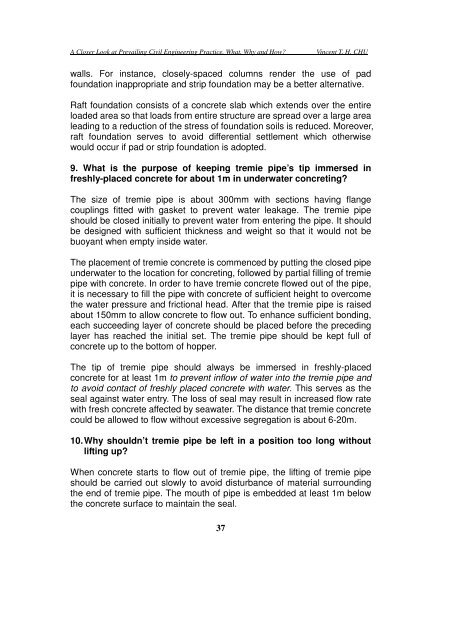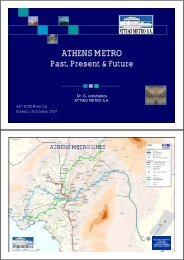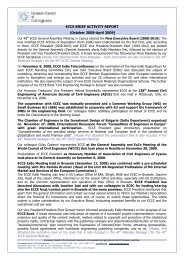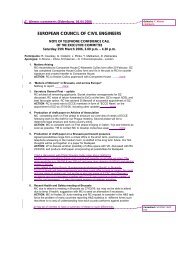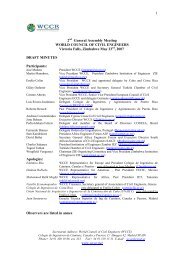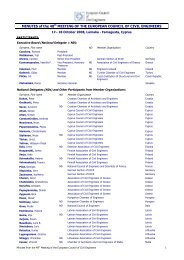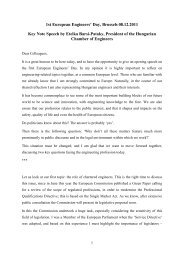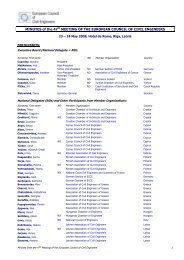A Closer Look at Prevailing Civil Engineering Practice - European ...
A Closer Look at Prevailing Civil Engineering Practice - European ...
A Closer Look at Prevailing Civil Engineering Practice - European ...
Create successful ePaper yourself
Turn your PDF publications into a flip-book with our unique Google optimized e-Paper software.
A <strong>Closer</strong> <strong>Look</strong> <strong>at</strong> <strong>Prevailing</strong> <strong>Civil</strong> <strong>Engineering</strong> <strong>Practice</strong>, Wh<strong>at</strong>, Why and How<br />
Vincent T. H. CHU<br />
walls. For instance, closely-spaced columns render the use of pad<br />
found<strong>at</strong>ion inappropri<strong>at</strong>e and strip found<strong>at</strong>ion may be a better altern<strong>at</strong>ive.<br />
Raft found<strong>at</strong>ion consists of a concrete slab which extends over the entire<br />
loaded area so th<strong>at</strong> loads from entire structure are spread over a large area<br />
leading to a reduction of the stress of found<strong>at</strong>ion soils is reduced. Moreover,<br />
raft found<strong>at</strong>ion serves to avoid differential settlement which otherwise<br />
would occur if pad or strip found<strong>at</strong>ion is adopted.<br />
9. Wh<strong>at</strong> is the purpose of keeping tremie pipe’s tip immersed in<br />
freshly-placed concrete for about 1m in underw<strong>at</strong>er concreting<br />
The size of tremie pipe is about 300mm with sections having flange<br />
couplings fitted with gasket to prevent w<strong>at</strong>er leakage. The tremie pipe<br />
should be closed initially to prevent w<strong>at</strong>er from entering the pipe. It should<br />
be designed with sufficient thickness and weight so th<strong>at</strong> it would not be<br />
buoyant when empty inside w<strong>at</strong>er.<br />
The placement of tremie concrete is commenced by putting the closed pipe<br />
underw<strong>at</strong>er to the loc<strong>at</strong>ion for concreting, followed by partial filling of tremie<br />
pipe with concrete. In order to have tremie concrete flowed out of the pipe,<br />
it is necessary to fill the pipe with concrete of sufficient height to overcome<br />
the w<strong>at</strong>er pressure and frictional head. After th<strong>at</strong> the tremie pipe is raised<br />
about 150mm to allow concrete to flow out. To enhance sufficient bonding,<br />
each succeeding layer of concrete should be placed before the preceding<br />
layer has reached the initial set. The tremie pipe should be kept full of<br />
concrete up to the bottom of hopper.<br />
The tip of tremie pipe should always be immersed in freshly-placed<br />
concrete for <strong>at</strong> least 1m to prevent inflow of w<strong>at</strong>er into the tremie pipe and<br />
to avoid contact of freshly placed concrete with w<strong>at</strong>er. This serves as the<br />
seal against w<strong>at</strong>er entry. The loss of seal may result in increased flow r<strong>at</strong>e<br />
with fresh concrete affected by seaw<strong>at</strong>er. The distance th<strong>at</strong> tremie concrete<br />
could be allowed to flow without excessive segreg<strong>at</strong>ion is about 6-20m.<br />
10. Why shouldn’t tremie pipe be left in a position too long without<br />
lifting up<br />
When concrete starts to flow out of tremie pipe, the lifting of tremie pipe<br />
should be carried out slowly to avoid disturbance of m<strong>at</strong>erial surrounding<br />
the end of tremie pipe. The mouth of pipe is embedded <strong>at</strong> least 1m below<br />
the concrete surface to maintain the seal.<br />
37


